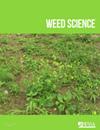外来入侵仙人掌--对冲仙人掌(Cereus uruguayanus)的发芽对环境因素的反应
IF 2.1
2区 农林科学
Q2 AGRONOMY
引用次数: 0
摘要
绿篱仙人掌(Cereus uruguayanus R. Kiesling;同义词:Cereus hildmannianus K. Schum.)是一种柱状仙人掌,被引入澳大利亚作为观赏植物,现已入侵昆士兰和新南威尔士的亚湿润地区。与其同属植物 Cereus jamacaru DC.(目前在非洲东部和南部均有入侵)相比,缺乏有关 C. uruguayanus 种子生物学的信息。实验研究了昼夜温度交替、盐胁迫、水胁迫和埋藏深度对 C. uruguayanus 四种种子萌发和出苗的影响。还对种子进行了控制老化试验(CAT),以估计其在田间条件下的潜在持久性。发芽率随氯化钠(NaCl)浓度的增加而降低,但在 160 mM NaCl 浓度下,所有品种都能发芽(范围为 26-81%),表明其具有很强的耐盐性。种子的发芽率随着水分胁迫的增加而逐渐降低,但在-0.8 兆帕时,所有品种的发芽率都有所提高(范围为 19-47%)。种子活力和潜在发芽率不受盐度(320 mM NaCl)和水(-1.6 MPa)胁迫的影响,在这两种胁迫下种子不发芽。对所有三个因素的发芽反应与记录的 C. jamacaru 大致相似。随着种子埋藏深度的增加,C. uruguayanus 的萌发率下降。表播种子的萌发率最高(43%),埋藏深度为 2 厘米时,萌发率降至 0。对两个种子品种的 CAT 结果表明,C. uruguayanus 的种子在田间条件下可能会有较长(> 3 年)的存活期,其小种子(2 毫米)的发芽率因埋藏而明显降低的证据也支持了这一预测。本文章由计算机程序翻译,如有差异,请以英文原文为准。
Germination responses of the invasive cactus, hedge cactus (Cereus uruguayanus) to environmental factors
Hedge cactus (Cereus uruguayanus R. Kiesling; syn. Cereus hildmannianus K. Schum.) is a columnar cactus that was introduced to Australia as an ornamental plant and has since become invasive in subhumid regions of Queensland and New South Wales. Compared to its congener Cereus jamacaru DC. (which currently is invasive in both eastern and southern Africa), information on seed biology of C. uruguayanus is lacking. Experiments were conducted to study the effects of alternating day/night temperature, salt stress, water stress, and burial depth on germination and seedling emergence of four seed accessions of C. uruguayanus. Seeds were also subjected to a Controlled Aging Test (CAT) to obtain an estimate of potential persistence under field conditions. The optimum temperature regime for germination of all accessions was 30/20 C. Germination decreased with an increase in sodium chloride (NaCl) concentrations, but germination of all accessions (range 26–81%) occurred at 160 mM NaCl, indicating very high salt tolerance. Seed germination gradually decreased with an increase in water stress, but germination in all accessions (range 19–47%) occurred at -0.8 MPa. Seed viability and potential germinability were unaffected by exposure to salt level (320 mM NaCl) and water (-1.6 MPa) stress under which germination did not occur. Germination responses to all three factors were generally similar to those documented for C. jamacaru. The emergence of C. uruguayanus decreased with an increase in seed burial depth. The highest emergence (43%) was recorded for surface-sown seeds and emergence was reduced to 0 at a burial depth of 2 cm. CAT results for two seed accessions indicated that seeds of C. uruguayanus are likely to demonstrate extended (> 3 yr) persistence under field conditions, a prediction that is supported by evidence that germination of its small (2 mm) seeds is markedly reduced by burial.
求助全文
通过发布文献求助,成功后即可免费获取论文全文。
去求助
来源期刊

Weed Science
农林科学-农艺学
CiteScore
4.60
自引率
12.00%
发文量
64
审稿时长
12-24 weeks
期刊介绍:
Weed Science publishes original research and scholarship in the form of peer-reviewed articles focused on fundamental research directly related to all aspects of weed science in agricultural systems. Topics for Weed Science include:
- the biology and ecology of weeds in agricultural, forestry, aquatic, turf, recreational, rights-of-way and other settings, genetics of weeds
- herbicide resistance, chemistry, biochemistry, physiology and molecular action of herbicides and plant growth regulators used to manage undesirable vegetation
- ecology of cropping and other agricultural systems as they relate to weed management
- biological and ecological aspects of weed control tools including biological agents, and herbicide resistant crops
- effect of weed management on soil, air and water.
 求助内容:
求助内容: 应助结果提醒方式:
应助结果提醒方式:


